Nokia SRA Composite Exam
Last Update 4 days ago
Total Questions : 639
4A0-C02 is stable now with all latest exam questions are added 4 days ago. Just download our Full package and start your journey with Nokia SRA Composite Exam certification. All these Nokia 4A0-C02 practice exam questions are real and verified by our Experts in the related industry fields.
What happens to a route that is rejected by an import policy on an Alcatel-Lucent 7750 SR?
Click the exhibit.
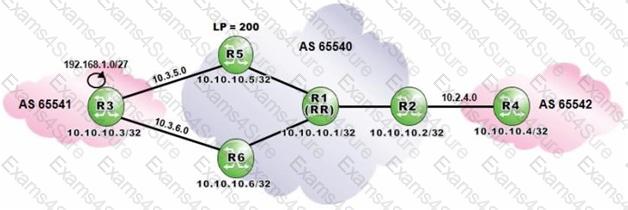
Router R1 is a route reflector with clients R2, R5 and R6. Prefixes advertised by router R5 have a local preference of 200. Router R3 advertises the prefix 192.168.1.0/27 to routers R5 and R6.
Assuming that router R6 is configured with "advertise-external", what is the expected output of "show router bgp routes" when executed on router R5?
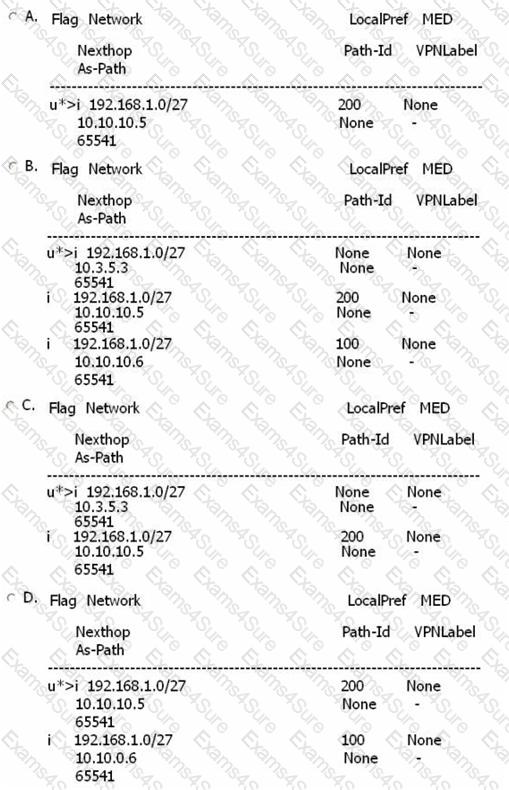
Click on the exhibit.

AS 65540 is using MPLS to provide BGP shortcuts for its iBGP routing. AS 65541 is advertising prefix 192.168.1.0/27 into BGP. Which routers have the BGP update for the advertised prefix in their BGP table?
An Alcatel-Lucent 7750 SR is configured with a local preference of 250. If it receives a BGP update with a local preference of 500, what local preference is sent to its eBGP peers?
Assuming that "client1" and "client2" are directly-connected networks, what is the result of executing the following BGP export policy?
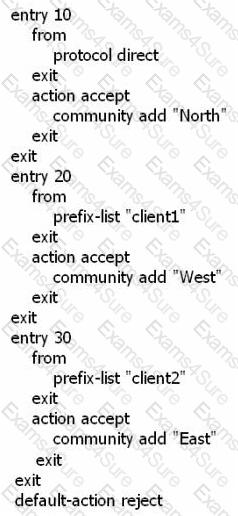
Click the exhibit.
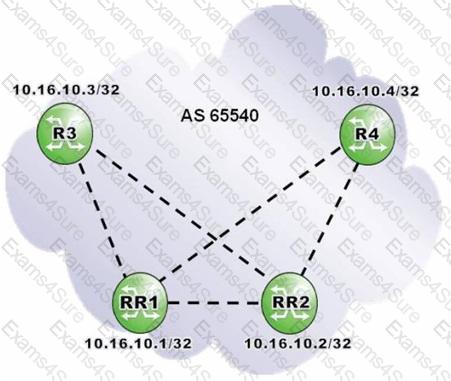
Routers RR1 are RR2 are redundant route reflectors for clients R3 and R4. Which of the following is a valid configuration on router R3?
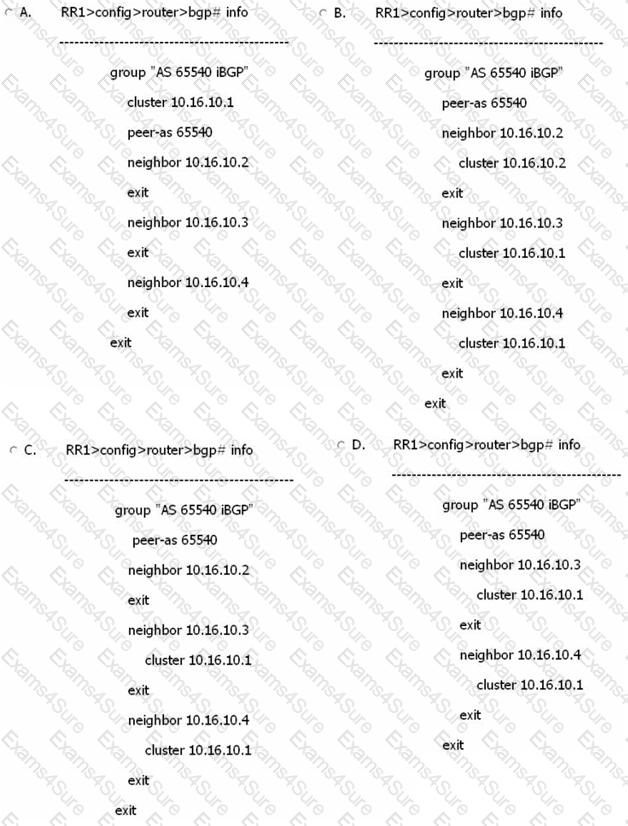
Which of the following statements regarding the Originator_ID attribute is TRUE?
Click the exhibit.
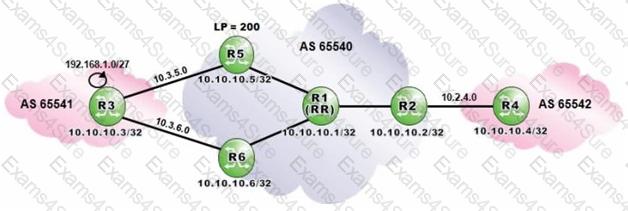
Router R1 is a route reflector with clients R2, R5 and R6. Prefixes advertised by router R5 have a local preference of 200. Router R3 advertises the prefix 192.168.1.0/27 to routers R5 and R6.
Assuming that none of the routers in AS 65540 is configured with "advertise-external", what is the expected output of "show router bgp routes" on router R5?
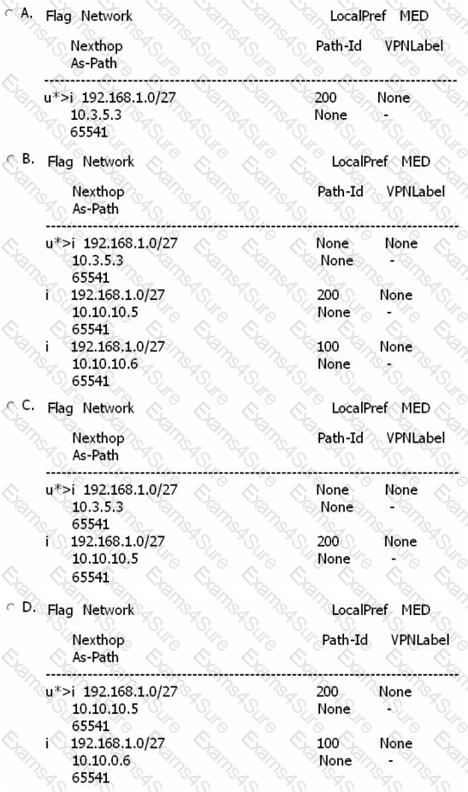
Click the exhibit.

Router R1 is a route reflector with clients R2, R5 and R6. Router R3 advertises the prefix 192.168.1.0/27 to routers R5 and R6. Assuming that routers R1, R2 and R4 are configured with "add-paths ipv4 send 2 receive", what is the expected output of "show router bgp routes" when executed on router R2?
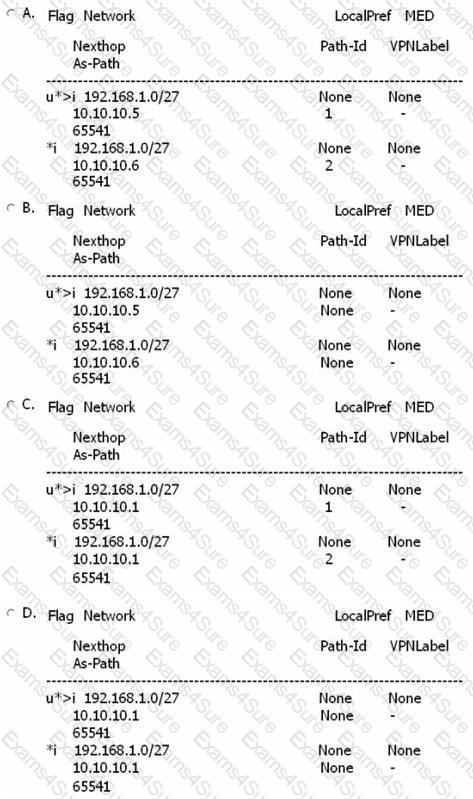
Which of the following statements about the BGP Advertise External feature is FALSE?
Click on the exhibit.

AS 65540 is using MPLS to provide BGP shortcuts for its iBGP routing. Which routers must be configured with the "configure router bgp igp-shortcuts rsvp-te" command?
Click the exhibit.
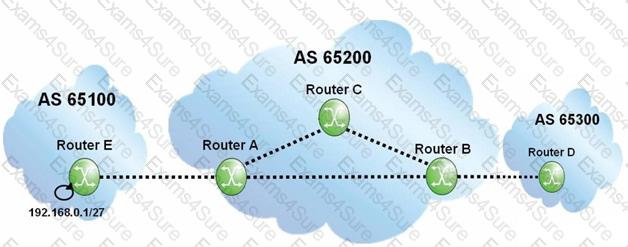
Assuming router A is configured with "next-hop-self", what does the BGP update for prefix 192.168.0.1/27 contain when it arrives at router B?
Click the exhibit.
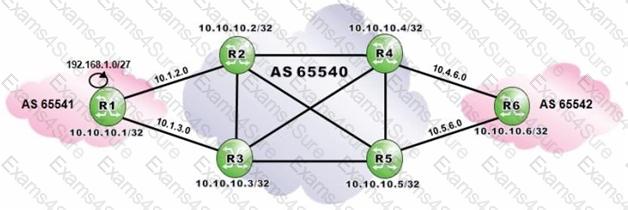
AS 65540 routers are iBGP fully-meshed. Assume routers R4, R5 and R6 are configured with addpaths ipv4 send 2 receive". Which routes to 192.168.0.1/27 is router R6 expected to have in its BGP routing table?
Click the exhibit.
AS 65540 routers are iBGP fully-meshed. Prefixes advertised by router R2 have a local preference of 200. Router R1 advertises the prefix 192.168.1.0/27 to routers R2 and R3. Assuming that router R3 is configured with "advertise-external", what is the expected output of "show router bgp routes" when executed on router R4?
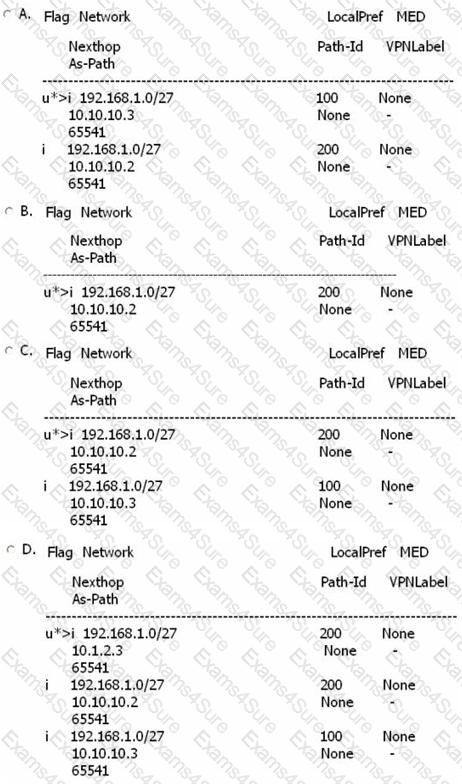
Which of the following parameters does NOT have to match for an iBGP session to be successfully established?
When implementing a BGP policy on an Alcatel-Lucent 7750 SR, which of the following types of address space would a typical address plan need to cover?
When an Alcatel-Lucent 7750 SR receives a BGP route with an AS Path loop, what action is taken by default?
Click on the exhibit below.

Assume the port on CE-A is sending two tags, a top tag of 100 and a bottom tag of 500. PE-A is configured with a SAP id of 1/1/1:100.*. How should PE-B be configured if CE-B is expecting a top tag of 200 and a bottom tag of 500?
RSTP blocks a spoke-sdp using a management VPLS. Is traffic affected on an ES using the same transport SDP?
The service mtu of a VPLS is set to 9100. What is the recommended MTU value that can be set for the access port assuming dot1q encapsulation?
Which PDU type is sent periodically over a link in the IEEE 802.3ah EFM as a method of keepalive?
Click on the exhibit below.
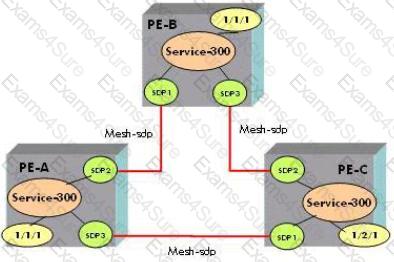
Assume a CE router is connected to the SAP of each P
E.
The arp cache of all CE routers is empty and the FDB for VPLS 300 is empty. The CE router connected to PE-A initiates a ping towards the CE router connected to PE-C.
The ping is successful. Which of the following statements are true? (Choose 2)An l-VPLS is configured with a service id of 511. What will the value of the l-SID be assuming a default configuration?
Click on the exhibit below.

In the diagram below, SAP 1 is put into the blocking state as a result of the spanning tree protocol. What will occur in the VPLS instance if SAP 2 goes down and SAP 1 transitions to the forwarding state? Select the most accurate statement.
Click on the exhibit below.
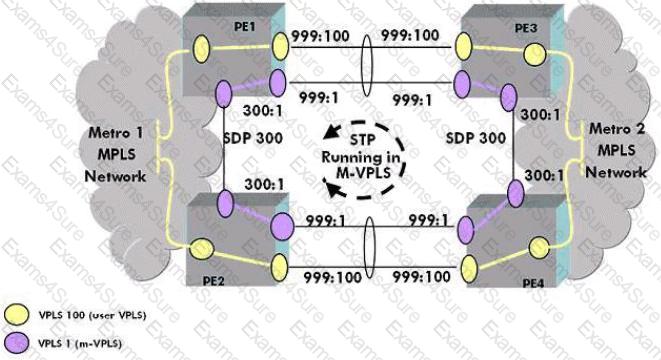
Study the network diagram. Which of the following configurations is correct for user VPLS 100 on PE4?
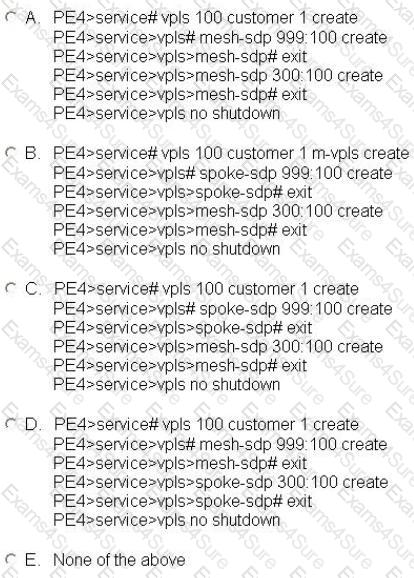
Click on the exhibit below.

The SAP on PE-A has been configured with dot1q encapsulation. The SAP on PE-B has been configured with qinq encapsulation. CE-A sends frames with a single tag of 100. The VLAN tag from CE-A must be passed transparently. CE-B is expecting a frame with a top tag of 200 and bottom tag of 100. Which of the following is the correct SAP id for PE-B?
What function in IEEE 802.1 ah helps to limit the amount of MAC addresses learned in the core?
Which OAM tool can be used to dynamically learn the MAC address of a CE device connected to a SAP within a VPLS service?
Consider a large metro-to-metro VPLS network interconnected with a mesh of mesh-SDPs. Which of the following statements does NOT apply to this situation?
The "discard-unknown" command has been enabled at the VPLS level. Which of the following statements is true? (Choose 2)
An MC-LAG is configured with default parameters. When a failed interface recovers, the active link reverts to the restored interface.
When a PE node receives a PBB encapsulated frame on a B-VPLS, how does the PE determine which l-VPLS it belongs to?
Click on the exhibit below.
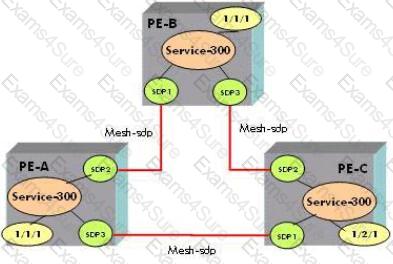
A new router named PE-D is to be directly connected to PE-C and is required to be added to the existing VPLS 300. The design requires the least amount of signaling, the least amount of configuration changes for existing sites and the new site has to have access to all existing sites. How should the new site be added to VPLS 300?
Click on the exhibit below.
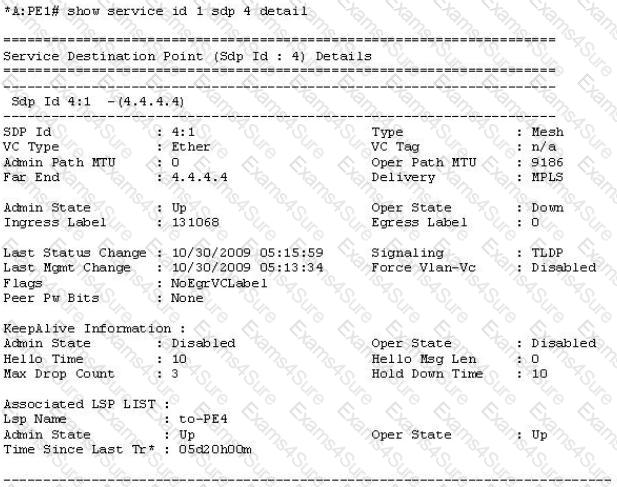
Given the following output what is the most likely reason the SDP binding is operationally down? (Choose 2)
Which of the following needs to be considered when designing Ethernet networks with redundancy?
Click on the exhibit below.
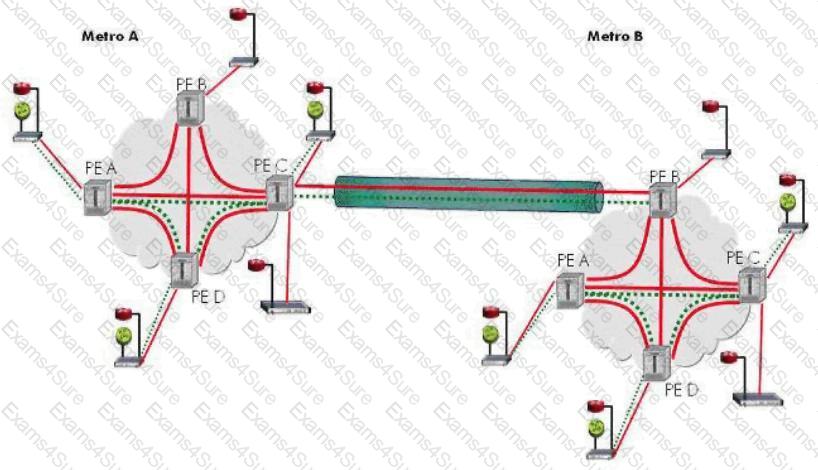
A new site is added to PE-D of Metro
B.
Which of the following statement below is true?Click the exhibit.
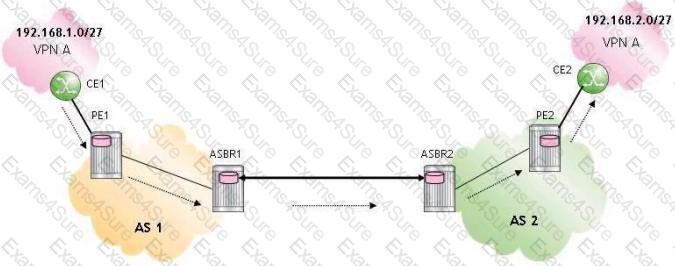
For the inter-AS model A VPRN. BGP is used as the PE-CE routing protocol. Which of the following statements about the control plane operation is TRUE?
When configuring a VPRN service on an Alcatel-Lucent 7750 SR, where should the following policy be applied?

Which protocol is used to exchange customer VPRN routes between PE devices?
For a Carrier Supporting Carrier (CSC) VPRN where the customer carrier is an ISP that provides Internet connectivity to its end-customers, which of the following is TRUE?
When a Service Provider offers VPRN services to its customers, which of the following functions are expected to be the responsibility of the Service Provider? (Choose three)
Click the exhibit.
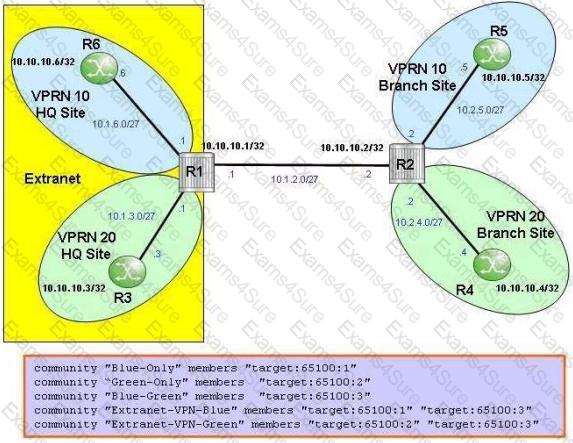
The headquarter sites of VPRN 10 and VPRN 20 ate part of an extranet VPRN. Which of the following communities are included in the export policy applied to VPRN 10 on router R1?
Click the exhibit.
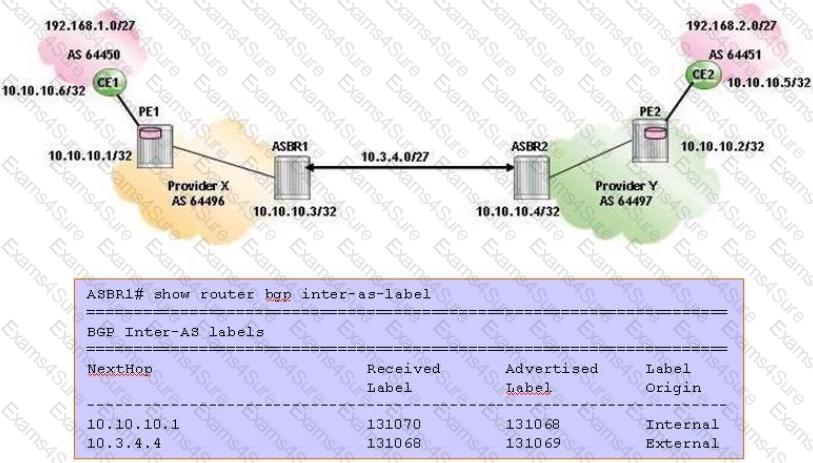
For the Inter-AS model B VPRN, which of the following about the inter-as-label output on ASBR1 is TRUE?
When configuring BGP as the PE-CE protocol on an Alcatel-Lucent 7750 SR, the configuration on the CE is done under the ____________ context and the PE configuration is under the ____________ context.
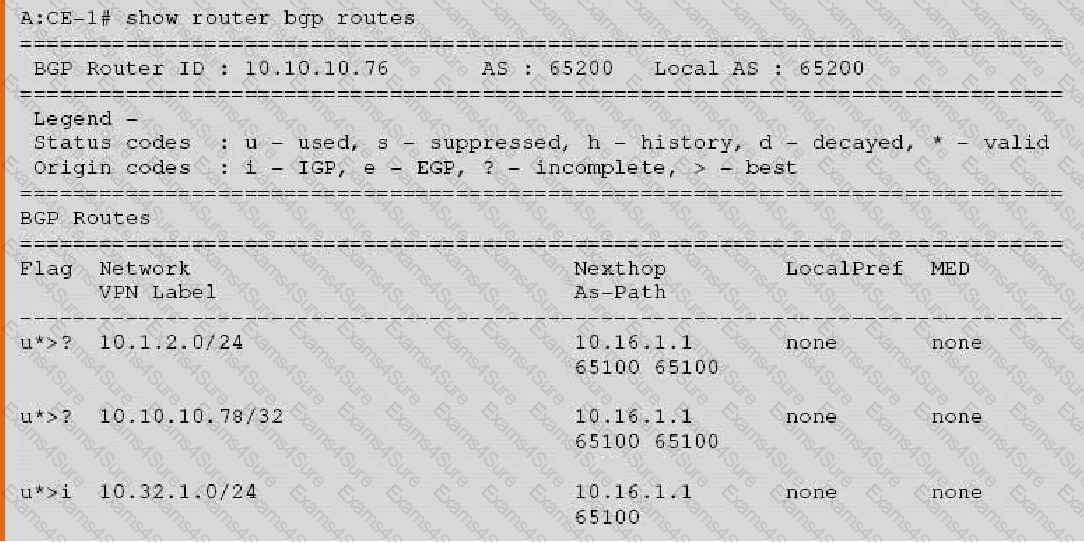
Click the exhibit.
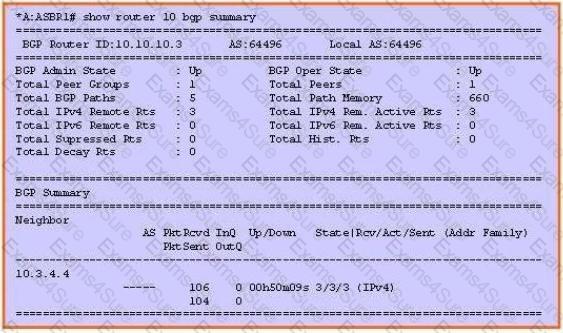
The displayed output is from an ASBR supporting an inter-AS model A VPRN. Which of the following statements about this output is TRUE?
Which of the following about the configuration of VPRN Outbound Route Filtering (ORB on an Alcatel-Lucent 7750 SR is TRUE?
For Carrier Supporting Carrier (CSC) VPRN, which of the following is NOT applicable to both types of customer carriers: BGP/MPLS service providers and Internet service providers?
Click the exhibit.
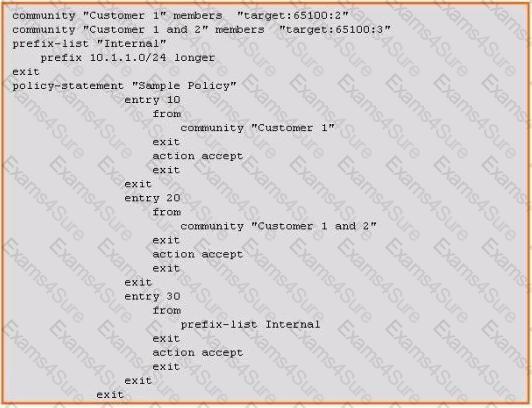
The policy shown is configured on an Alcatel-Lucent 7750 SR to implement an extranet VPRN between the main sites of two separate VPRNs. Route target "target:65100:2" is used for Customer 1 routes, and route target "target:65100:3" is used for Extranet routes. How should this policy be applied?
Click the exhibit.

A Carrier Supporting Carrier (CSC) VPRN is configured for a customer carrier who is an Internet Service Provider (ISP). Which of the following about route distribution is FALSE?
Which of the following statements are true regarding P devices in an MPLS VPRN? (Choose two.)
Which command is used to generate the output from an Alcatel-Lucent 7750 SR shown below?

Click the exhibit.

For the inter-AS model B VPRN, which of the following is FALSE when CE2 sends an IP packet to 192.168.1.1?
An SDP has been configured for a VPRN service using an existing MPLS LSP and the configuration shown below. Which of the statements below is true about the configuration on an Alcatel-Lucent 7750 SR?
Click the exhibit.
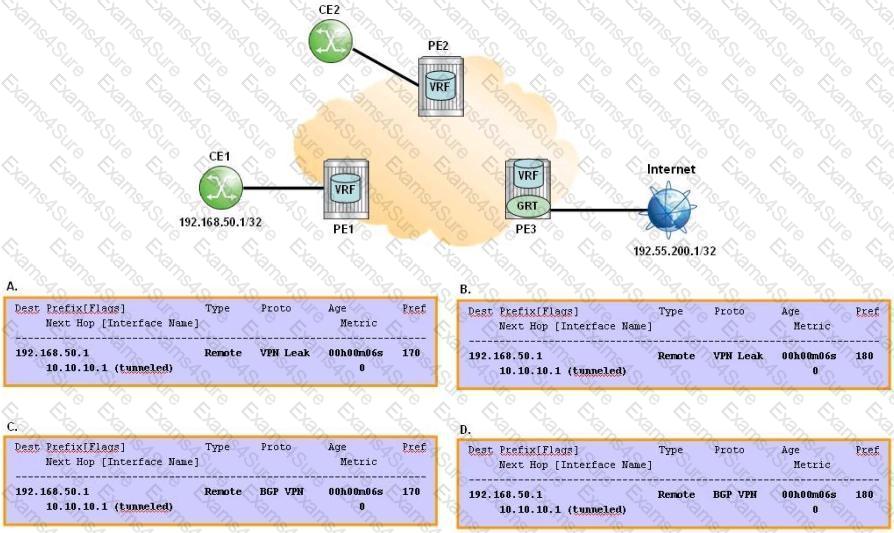
Internet access using route leaking between the VRF and the global routing table is configured in the network. Which of the following is the correct output of route 192.168.50.1 in the global routing table of PE3?
On a PE router, the VRF table for VPRN 10 contains: one local route, two BGP routes learned from a local C
E.
and three tunneled routes learned from a remote site. If we execute the command "configure service vprn 10 maximum-routes 2 log-only" on this PE router, how many routes are expected to be in the VRF?On the Alcatel-Lucent 7750 SR, what is the maximum number of queues that a single SAP-ingress policy can support in a VPLS?
Click the exhibit button below. Given the slope-policy (below), which of the following statements are TRUE? (Choose two)
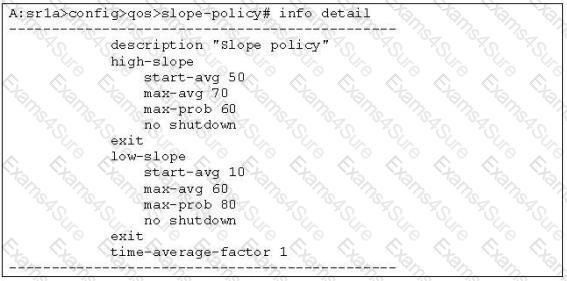
A queue is configured with the following attributes:
MBS = 10KB
CBS = 5KB
High-Priority-Only = 30%
Assume that there is no CBS overbooking and that the slope-policy is disabled. If the current queue depth is 8KB, what will happen to an in-profile packet arriving in the queue?
On the Alcatel-Lucent 7750 SR, where can network-queue policies be applied? (Choose two)
If traffic is destined to queue 5, which has a high-priority-only value of 0 in the network-queue policy, all out-of-profile packets will be dropped.
A service provider is using GRE for his transport tunnel on the Alcatel-Lucent 7750 SR. How can traffic be marked as it traverses the service provider's network? (Choose two)
Which of the following are possible criteria for classifying packets at the SAP-ingress? (Choose three)
Click the exhibit button below.
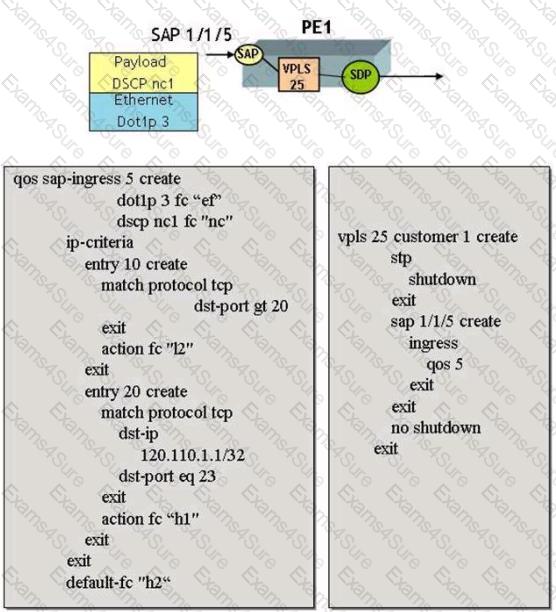
Based on the configuration shown below, name the forwarding class to be associated with a TCP packet encapsulated inside an Ethernet frame that arrives on SAP 1/1/5 with the following characteristics:
Destination IP address = 120.110.1.1
TCP port number = 23
DSCP value = nc1
Dot1pvalue = 3
Click the exhibit button below. Given the SAP-ingress policy, which of the following statements are TRUE? (Choose three)
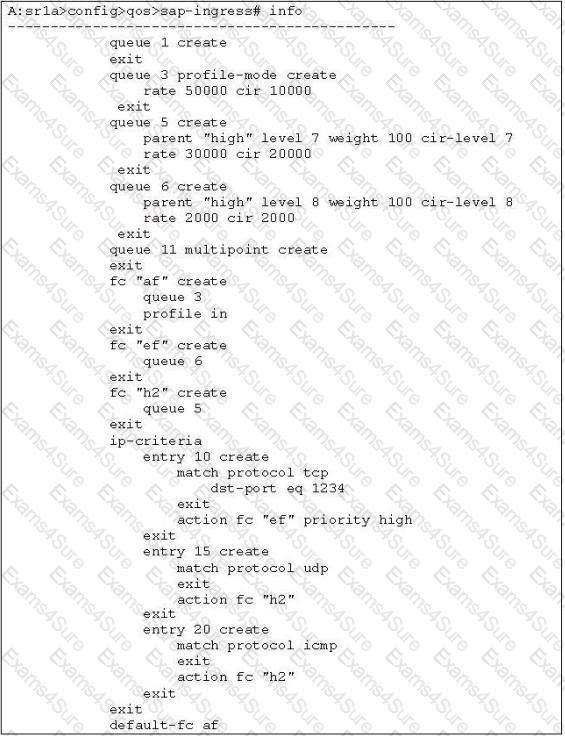
In which policies, on the Alcatel-Lucent 7750 SR. is classification performed? (Choose three)
A default network policy is applied to all router interfaces associated with network ports.
In which of the following scenarios is the egress port scheduler useful? (Choose two)
A packet is to be encapsulated inside an MPLS tunnel which consists of two MPLS headers at the first network egress. Which of the MPLS EXP fields will be marked?
Which of the following statements regarding the egress port scheduler is TRUE?
Which of the following are entities of the Alcatel-Lucent 7750 SR on which you can NOT apply a network-queue policy? (Choose three)
Which of the following rate-limiting approaches are used on the Alcatel-Lucent 7750 SR? (Choose two)
According to the SAP-ingress QoS policy shown, which packets have a higher priority to enter queue 6?
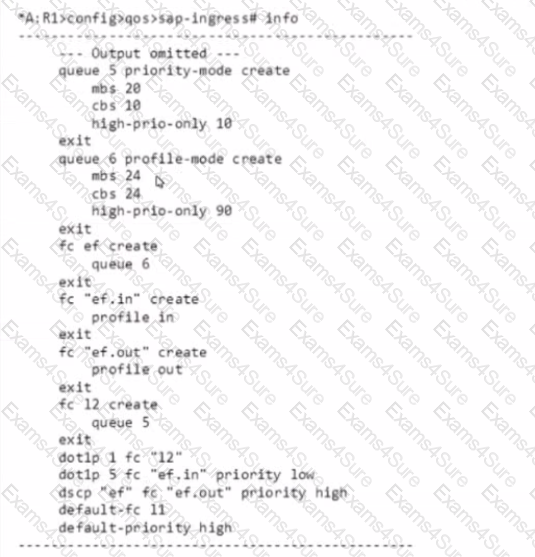
Click the exhibit button below. A network operator has configured the SAP-ingress policy below. Ping traffic is expected in queue 3. However, the network operator notices that all traffic is placed in queue 1. What is the most probable reason for this?
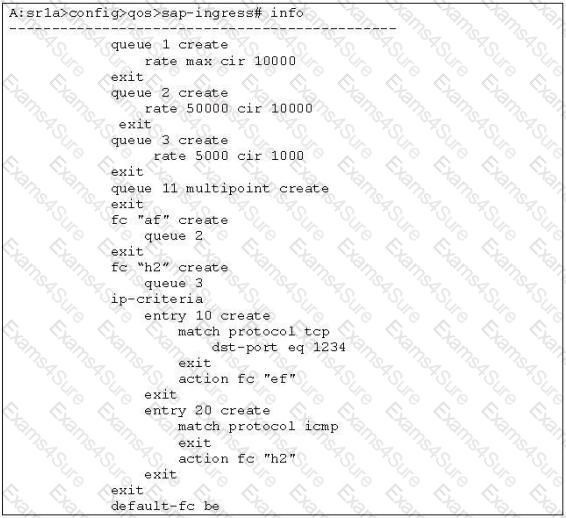
The port groups have been configured consistently on the PE routers, as highlighted in the exhibit. Which SDP connection will be blocked first when the re-learn rate is exceeded?
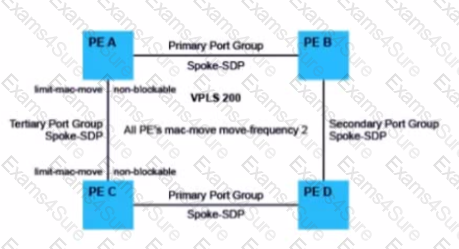
On the Alcatel-Lucent 7750 SR, how many queues per FC are available for multipoint traffic within a VPLS on service ingress?
Given the scheduler-policy parameters shown, and assuming the offered rate of each queue is 10 Mbps, what are the operational PIR and CIR for queue 1?
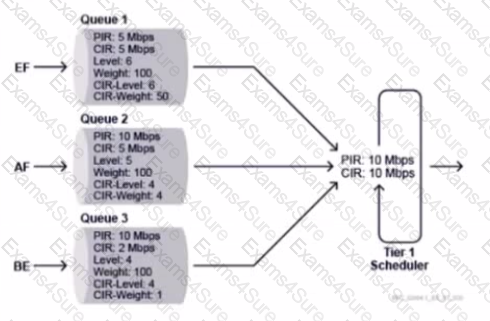
When using an egress port scheduler, on which scheduling loop are orphaned queues serviced?


TESTED 27 Apr 2024
Hi this is Romona Kearns from Holland and I would like to tell you that I passed my exam with the use of exams4sure dumps. I got same questions in my exam that I prepared from your test engine software. I will recommend your site to all my friends for sure.
Our all material is important and it will be handy for you. If you have short time for exam so, we are sure with the use of it you will pass it easily with good marks. If you will not pass so, you could feel free to claim your refund. We will give 100% money back guarantee if our customers will not satisfy with our products.